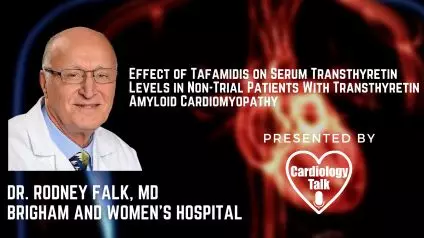Dr. Rodney H. Falk, MD- Effect of Tafamidis on Serum Transthyretin Levels in Non-Trial Patients With Transthyretin Am...
Dr. Rodney H. Falk is the director of the Cardiac Amyloidosis Program at Brigham and Women's Hospital and a cardiovascular medicine specialist (BWH). He is also a Harvard Medical School associate professor of medicine. In this video Dr. Falk speaks on the Effect of Tafamidis on Serum Transthyretin Levels in Non-Trial Patients With Transthyretin Amyloid Cardiomyopathy.
Link to Abstract:
https://www.jacc.org/doi/10.1016/j.jaccao.2021.08.007
Abstract:
Abstract \sBackground
Tafamidis slows the progression of transthyretin amyloid (ATTR) cardiomyopathy by stabilizing the TTR molecule and reducing the production of amyloidogenic oligomers. In clinical doses, stabilizers raise serum TTR, which could be a proxy for the degree of stabilization.
Objectives
The goal of this study is to investigate the effect of tafamidis on serum TTR levels in a non-trial, unselected group of individuals with ATTR cardiomyopathy, and to compare these results to published data on TTR alterations.
Methods
TTR levels were measured before and 3 to 12 months after starting tafamidis medication in all patients who had a follow-up visit within 12 months of starting therapy between May 20, 2019 and March 1, 2021.
Results
Administration of tafamidis increased serum TTR from 21.8 mg 0.7 mg/dL to 29.3 0.86 mg/dL, a 34.5 percent rise, in 72 individuals with ATTR cardiomyopathy (67 patients with wild-type and 5 patients with mutant TTR). The rise was 70.9 percent in 5 patients with mutant TTR, compared to 32.0 percent in wild-type patients. Over a mean follow-up of 21 1.2 weeks, mean N-terminal pro-brain natriuretic peptide increased, but the change was not statistically significant. Over the same time period, there was a slight but statistically significant increase in high-sensitivity troponin T (P = 0.057).
Conclusions
In individuals with ATTR cardiomyopathy, Tafamidis reliably raises serum TTR levels, which is consistent with its action on TTR stabilization. TTR level change after TTR stabilizing therapy could be a surrogate for stability and a more accurate indicator of pharmacological efficacy than a nonphysiologic in vitro test of stabilization.
Introduction
Transthyretin (TTR), a 55-kDa homotetramer, is the second most abundant protein in the body after albumin. It has a half-life of approximately 48 hours and is detected in normal human serum at a concentration of 20 to 40 mg/dL. TTR-derived amyloid (ATTR) cardiomyopathy is a newly described condition characterized by transthyretin-derived variant or wild-type amyloid infiltration of the heart. Small compounds that stabilize TTR, reducing degradation into amyloidogenic monomers, is one therapy option. Diflunisal, tafamidis, and acoramidis (AG10) are the three major stabilizing medications used in the treatment of ATTR cardiomyopathy and neuropathy (1–5). Only the first two are accessible in clinical trials, and AG10 is presently being evaluated in a pivotal trial. Tafamidis binds to the TTR tetramer's thyroxine-binding region, preventing it from dissociating into monomers. In this way, the cascade that leads to amyloid development in susceptible patients is slowed down (3,6). The ATTR-ACT (Safety and Efficacy of Tafamidis in Patients With Transthyretin Cardiomyopathy) trial found that tafamidis was effective in slowing the progression of amyloid cardiomyopathy, with fewer 30-month hospitalizations for congestive heart failure and lower mortality in tafamidis-treated patients than in placebo-treated patients (4). Both the placebo and treatment groups saw a decrease in the 6-minute walk test over time, although the tafamidis patients saw a smaller decrease. The N-terminal pro-brain natriuretic peptide (NT-proBNP) increased in both treated and placebo patients, however tafamidis patients had a statistically significant lower rise than placebo patients. As a result, tafamidis slowed but did not stop disease progression as evaluated by morbidity and mortality. The persistent decline in clinical condition among tafamidis-treated patients could be explained in two ways. One theory is that tafamidis fails to properly stabilize the TTR molecule, allowing amyloid formation in the heart to continue, albeit at a slower rate than in untreated patients. Alternatively, despite the absence of additional amyloid deposition, poorer exercise tolerance and increased NT-proBNP in the tafamidis-treated group could just be the natural development of heart failure in a badly injured ventricle (7).
The idea that a higher drug-induced TTR stability could better has tafamidis results has sparked interest in AG10, which is currently being tested in clinical studies (5,8). AG10 was developed to match the structural form of the TTR "super-stabilizer" variation, T119M, and hence has a slightly different mode of stabilization than tafamidis. AG10 establishes hydrogen bonds with serine residues at the same position as the T119M variation, and it is thought to be a more effective TTR stabilizer than tafamidis based on assays of stabilization (9,10). However, one of the primary challenges in predicting greater TTR stabilizer efficacy based on stabilization assays is that there are multiple assays, all of which are performed under nonphysiologic settings. Furthermore, even if one medicine provides more stability in vitro than another, the efficacy in a human or animal model is determined by the drug's half-life and absorption rate.
Because TTR stabilizers do not appear to change the pace at which the liver produces TTR, an increase in TTR levels following tafamidis administration is most likely due to a longer TTR half-life. TTR has a 48-hour half-life in humans, which is identical to that of tafamidis, and optimum TTR stability occurs 4 weeks after starting the bioequivalent formulations tafamidis meglumine 80 mg daily or tafamidis 61 mg daily (3,11). As a result, it seems logical that measuring TTR levels before and after starting a therapeutically effective TTR stabilizer would be a consistent, if indirect, measure of drug efficacy that might potentially overcome the limitations of several in vitro nonphysiologic stabilization techniques. The effect of tafamidis meglumine 80 mg or tafamidis 61 mg on TTR levels in an unselected sample of patients with amyloid cardiomyopathy seen since tafamidis was approved for general clinical use in the United States is described here.
Methods
The records of all patients treated at our facility who were prescribed tafamidis between May 20, 2019 and March 1, 2021, when it was approved by the US Food and Drug Administration, were reviewed. At each visit to our amyloidosis program, we routinely evaluate serum TTR (prealbumin), NT-proBNP, and high-sensitivity troponin T (measured by photometrics [prealbumin] and chemiluminescence [NT-proBNP and high-sensitivity troponin] using a Roche Diagnostics cobas analyzer). Patients who were started on tafamidis were usually advised to come back in three months to see how they were doing and get a new TTR level. Patients receiving either tafamidis meglumine 80 mg or tafamidis 61 mg were included and evaluated together since they are bioequivalent (11). Patients were eligible for this trial if they had a baseline TTR level drawn within three months of starting tafamidis and a repeat level drawn at their follow-up appointment. We permitted measurement of a post-tafamidis TTR level up to 12 months after starting therapy because not all patients were able to return at 3 months (especially during the coronavirus disease-2019 pandemic). The study's main goal was to see how tafamidis affected TTR levels in clinically acceptable doses (80 mg or 61 mg), as well as any changes in the cardiospecific biomarkers NT-proBNP and high-sensitivity troponin T. Patients were excluded from the research if they were taking diflunisal right before starting tafamidis, were taking a lower dose of tafamidis meglumine (which comes in 20-mg pills), or had previously been treated with a TTR-silencing medication.
A positive endomyocardial biopsy or, more commonly, a positive technetium pyrophosphate scan in the absence of a plasma cell dyscrasia and in the presence of an echocardiographic or cardiac magnetic resonance appearance strongly suggestive of amyloid infiltration was used to diagnose transthyretin amyloidosis (ATTR). The Partners Institutional Review Board approved the analysis of these patients' data.
GraphPad Prism version 8.0.0 for Windows was used for statistical analysis (GraphPad Software). The paired Student's t-test was used to examine the changes from baseline, with a P value of 0.05 considered statistically significant. Unless otherwise stated, values are reported as mean SEM or mean SD. Data that are not normally distributed (e.g., troponin T and NT-proBNP levels) are provided as median (25th and 75th percentiles [Q1-Q3]), and the Wilcoxon signed rank test was used to compare the paired data.
Results
135 consecutive patients examined at the Brigham and Women's Hospital Amyloidosis Program between May 20, 2019 and March 1, 2021 received a prescription for tafamidis. Approximately 18 patients had previously used diflunisal, 12 patients did not begin therapy, 2 patients chose to reduce their dose from 80 mg to 20 mg due to drug expense, and 1 patient received just 20 mg daily due to a policy of the United States Veterans Administration. At the time of data collection, 25 of the remaining 102 patients had not returned within the 12-month window or had not reached their 3-month return appointment. Five patients who had been initiated on tafamidis by an outside physician without baseline TTR values were also removed from the study. As a result, there were 72 patients in the study group. The average age was 79.6 years, and all but three of the participants were men. There were 67 patients with wild-type TTR and 5 with mutant ATTR (4 with V122Ile and 1 woman with Thr60Ala).
Table 1 summarizes the most important information. TTR levels were 21.8 0.7 mg/dL on average for the entire cohort, with 27 (37.0%) having values between 11 and 19 mg/dL, which is below our laboratory's lower limit of normal (20 mg/dL). The mean TTR levels for the entire cohort had grown to 29.3 0.8 mg/dL after 21.0 1.2 weeks of medication, a 34.5 percent increase (P 0.0001). TTR levels were normalized in 23 of 27 individuals (85.2%) who fell below 20 mg/dL. After the 5 patients with variant TTR were excluded, the mean baseline TTR in the wild-type TTR patients was 21.9 0.7 mg/dL, which increased to 28.9 0.8 mg/dL, a 32.0 percent increase. The 5 patients with variant ATTR cardiomyopathy, on the other hand, had a baseline TTR level of 20.6 2.9 mg/dL but a 70.9 percent increase to 35.2 3.20 mg/dL. The Central Illustration graphically depicts the absolute and percentage variations in TTR levels.




